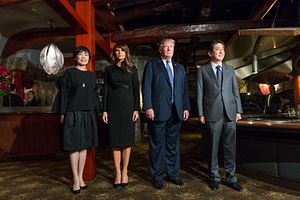U.S. President Donald J. Trump began his first Asia trip with a visit to Japan. During his stay in Japan from November 5 to 7, his host, Japanese Prime Minister Shinzo Abe, went all out to welcome the president and First Lady Melania Trump. Their itinerary was filled with a mixture of official and unofficial activities, which signaled the importance that Trump’s visit had for Japan.
In addition to the courtesy meeting with Emperor and Empress, Trump and Abe spent some quality time together. Aside from the official bilateral meeting in the afternoon of November 6, the two leaders had several additional occasions to engage in discussion, including their nine holes of golf in the afternoon of November 5, and the working lunch just prior to the official bilateral meeting. The Trumps also spent both of their nights in Japan dining with Prime Minister and Mrs. Abe — an informal steak dinner on November 5, and the official banquet on November 6.
In fact, Japan’s rolling out the red carpet to the Trumps preceded the presidential visit. When Trump’s daughter Ivanka was in Japan the previous week to deliver a speech at the 2017 World Assembly for Women (WAW) in Tokyo, Abe hosted her for dinner, while Foreign Minister Taro Kono and his wife hosted Ivanka for lunch. From a diplomatic protocol standpoint, it is extremely rare for not only the foreign minister but also the prime minister to host an adviser to the U.S. president who is not a cabinet member for separate meals. It was a clear signal that the Japanese government prioritizes optimizing the opportunity to personally engage the president and his family as a way to manage Tokyo’s relationship with Washington.
Trump’s visit to Japan has been met with mixed reviews, with much media attention going to the two leaders’ interaction and Trump’s behavior while in Japan. Some viewed Abe’s overtures toward the Trumps as Abe playing the role of “Trump’s loyal sidekick,” while others overreacted to the way Trump fed the fish in a koi pond while he was merely following Abe.
With so much attention going to how Trump (literally) behaved in Japan, not much attention was paid to what the two leaders discussed, with the clear exception of North Korea. Obviously, it makes sense that North Korea topped the agenda. After all, Trump traveling to Tokyo, Seoul, and Beijing before he moves on to Vietnam and the Philippines is meant to reassure anxious U.S. allies and reinforce the message to China to do everything it can to rein in the regime in Pyongyang. Trump’s meeting in Japan with the families of abductees (Japanese citizens who were kidnapped by North Korean agents, many of whom remain unaccounted for several decades later) reinforced the message that was articulated jointly by Trump and Abe — no dialogue for the sake of dialogue; now is the time to apply maximum pressure.
Beyond a strong display of a united front against North Korea and the reaffirmation of the importance of U.S.-Japan-South Korea cooperation, however, what came out of the summit looked very familiar. From the shared vision of the “Free and Open Indo-Pacific region” to reaffirmation of the commitment to continue discussions on bilateral trade, and the commitment to implement Futenma Replacement Facilities (FRF) in Okinawa, most of the items listed either had made their way into similar lists of “accomplishments” in the past, or were points that either Abe or Trump had spoken about previously. Bluntly put, the list can also be seen as a mere compilation of Abe and Trump’s respective priorities.
Such an outcome was entirely predictable, however. Going into this summit, the two leaders had to play a difficult balancing act. On the part of Trump, he obviously had to reiterate U.S. defense commitments to Japan, while having to cater to his domestic audience by following up on his tough rhetoric on “fair and open” trade that benefits the United States. On the part of Abe, he needed to showcase his ability to leverage his close personal relationship with Trump to his country’s benefit without looking too deferential to Trump. Above all, both leaders had to set the perception that the meeting — and Trump’s visit to Japan writ large — was a success.
On that point, the two leaders certainly have succeeded. Abe emerged from the summit reaffirming the perception that he has a rock-solid personal relationship with Trump while making no commitment on the most difficult bilateral trade issues. Trump also emerged from the summit celebrating the U.S.-Japan relationship and reaffirming U.S. alliance commitments while sending a message to his support base at home by talking tough on trade — including the speech he made in front of U.S. and Japanese business leaders at the U.S. Embassy in Tokyo, where he reasserted his belief that U.S. trade with Japan is “not fair and it’s not open.” Above all, Japanese people seemed to have welcomed the Trumps with positive excitement.
So, from the standpoint of perceptions, the visit was a “success.” Given the complex challenges that await the officials in the two governments, though, sustaining the positive atmosphere generated from the summit will not be very easy.

































